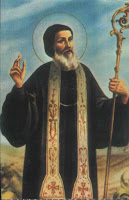Pope Benedict, on All Saints Day in 2008, proclaimed the
following words:

“With great joy, we celebrate today the feast of All Saints.
Visiting a nursery garden, one remains taken aback, at the variety of plants and flowers, and
spontaneously begins to think of the Creator's fantasy that made the earth a
marvelous garden. These same sentiments come to us when we consider the
spectacle of holiness: the world appears to us as a "garden," where
the Spirit of God has sustained with remarkable wonder, a multitude of saints,
male and female, from every age and social condition, of every tongue, people
and culture.
Each is different from the others, with the uniqueness of
their own personality and their own spiritual charisma. All, however, were
marked by the "seal" of Jesus, the imprint of his love, witnessed
upon the Cross. All now are at joy, in a feast without end. Like Jesus, they
reached this goal across toil and trial, each one encountering their share of
sacrifice to participate in the glory of the resurrection.”
Today, November the First, the Church celebrates the feast
of all saints. Welcome to the saint of the day.
The Book of
Revelation Chapter 7 verse nine and fourteen gives the magnificent
vision of the multitudes of saints gathered around the Lamb:
“After this I had a
vision of a great multitude, which no one could count, from every nation, race,
people, and tongue. They stood before the throne and before the Lamb, wearing
white robes and holding palm branches in their hands
One of the elders
said to me, ‘These are the ones who have survived the time of great
distress; they have washed their robes and made them white in the blood of the
Lamb. “
Indeed there are many saints in the Church’s roll of
saints and each has been given a special
day. There are also millions of saints who lived heroic Christian lives. They
are unknown and their story never told. This feast celebrates the feasts of all
saints. In this great galaxy of saints the supreme position is indeed
given to Mary Our Mother who is highest perfection of saint
hood.
Today we celebrate our communion with the all the saints who
have gone before us leading a life of holiness. The saints of God are living
entities just like each one of us. They constantly enjoy the blissful vision of
God and intercede for us in the presence of God.
All saints Day is a
day of hope for all of us, the hope that one day we will also find our place in
the book of life provided that we lead a
life based on the teachings of Christ. The feast is also a warning that Christian life is not
merely a member ship in the Church, it is an invitation to participate in the
life, death and resurrection of Jesus, in a special way. The supreme example of saint hood is that our
Lady. Her saint hood was her complete surrender of her will to the will of God,
so gloriously expressed in the first fiat, let thy will be done, that she
uttered at the time of annunciation.
Each of us is called to say a fiat, let thy will be done, in
our lives too. Indeed, each person’s acquiring of saint hood will be unique, based on the
calling and the special charisma with
which we are blessed.
















